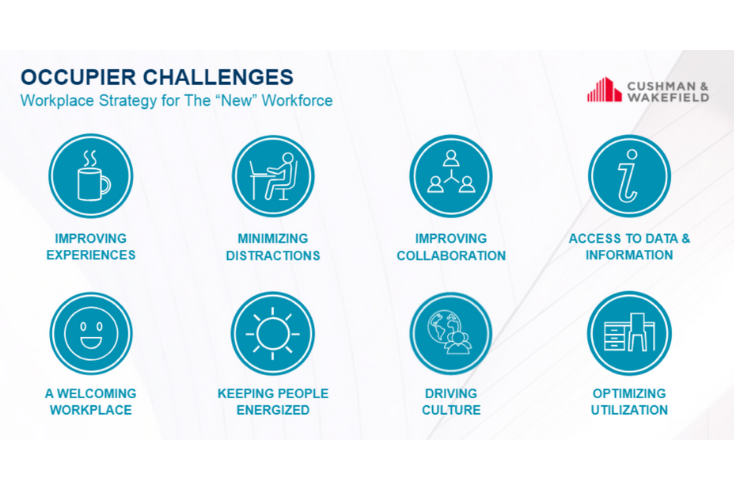- A Cushman & Wakefield webinar revealed the different elements shaping the US office market and the trends driving occupier demand.
- Many economists expect a recession within the next couple of years, but this does not appear to be dampening US property expansion.
- PropTech is having an impact on the workplace, which can reduce costs and make a space more efficient, but it’s important that the humanity of the space is kept intact.
During Cushman & Wakefield’s “What’s Shaping the Office Market: 2019 Occupier Trends” webinar, Steve Quick, Chief Executive of Global Occupier Services; Kevin Thorpe, Chief Economist and Global Head of Research; and David C. Smith, Americas Head of Occupier Research discussed the different elements shaping the US office market and the trends that are driving occupier demand.
According to Thorpe, US property expansion will continue and it will not be ending anytime soon despite the global economic slowdown. Even though the 2019 economy is slower, “the global economy is still growing and expanding, which translates into healthy demand for property.”
Still, many economists expect the next recession to occur in the next couple of years. 30% of economists believe the next recession will occur in 2020 and 50% say it’ll be in 2021.
However, Thorpe believes “‘there is no need to play scared.” Partly because the yield curve has not yet inverted (it’s only flattened) and also because, according to Thorpe, the next recession is not likely to be as severe as the one in 2008 and 2009, in great part because the US financial system is solid and it should help guard against a severe downturn.
“The expansion will continue for at least another couple of years. Stay aggressive.”
In light of this, what should real estate owners and stakeholders be thinking about? What’s shaping the CRE industry and what is driving occupier demand?
Overbuilding vs Under-demolishing
Contrary to what many believe, Thorpe believes the office sector is not overbuilding, but that rather it is under-demolishing.
“Nearly 70% of office inventory in the US is 20 years old or more and it hasn’t been renovated. The country doesn’t have too much new space, but it does have a lot of space that no one really wants.”
Thorpe also added that 2019 is expected to be the peak year of new completions, with some additional new space to be delivered in 2020.
Vacancy Rates and Density
Vacancy rates never got back to their historical average, and Thorpe believes this is a density trend more than an oversupply problem.
“Job growth has been outstanding in this cycle, but businesses are consuming less space.”
Smith agreed with Thorpe, arguing that “the amount of space allocated per individual is shrinking; allocation of square footage per employee has dropped about 10% since 2009.”
On the bright side, however, Smith argued that although the amount of space is smaller, the quality and effectiveness of the space is better. This lower density trend has also benefited occupiers in that rent growth has only increased 3 to 4% per annum.
Labor Shortages + the War for Talent
“Labor shortages are becoming one of the most significant challenges facing the CRE industry.” According to research presented by Thorpe, there are more job openings than unemployed people in the United States.
Suggested Reading: “Flexible Workspace as an HR Strategy”
Labor shortages have all sorts of implications, and specifically for CRE, it means that where companies locate and how they build out their space has never been as important as it is now.
Smith argued that “the workspace is an experience and that experience is really important in driving productivity, collaboration, and innovation, but also especially important to retain employees.”
“We are in a very tight labor market, where the number one concern for companies is attraction and retention of top talent.” Furthermore, Smith added that talent availability has become a top concern and priority when companies think about where to locate their offices and which markets to expand to.
Changes in the Workplace
Smith believes companies are increasingly focusing on how to create spaces that engage employees. Companies are also prioritizing flexibility and increasingly looking at coworking spaces to have flexibility within their space and to give employees flexibility on where they want to work from.
PropTech is also changing the workplace, and Smith cautions about technology integration into the everyday processes of a workspace. Though they can help reduce costs and make a space more efficient, it’s important that companies keep the humanity of the space intact.
Challenges and Improvements
Speaking about how companies can improve their space, Smith mentioned that companies are focusing on addressing 8 key aspects:

To better understand how they can improve their space and which elements a company should prioritize, Smith says the best solution is to ask employees. It’s crucial that companies understand how different types of people experience space, regardless of demographics.
The key takeaway is that a space needs to be built to help achieve business goals. In order for this to happen, employees need to have access to the necessary tools and resources to successfully carry out different types of tasks. A successful workplace is one where people can focus when they need to and where they can bond, learn, collaborate, and renew themselves.
As for the future, Smith mentioned that the majority of home purchases are in the suburbs. For millennials, proximity is highly important and they want to be close to work, transportation, and shopping and leisure.
Suggested Reading: “Is Suburban Coworking the Future of Work?”


 Dr. Gleb Tsipursky – The Office Whisperer
Dr. Gleb Tsipursky – The Office Whisperer Nirit Cohen – WorkFutures
Nirit Cohen – WorkFutures Angela Howard – Culture Expert
Angela Howard – Culture Expert Drew Jones – Design & Innovation
Drew Jones – Design & Innovation Jonathan Price – CRE & Flex Expert
Jonathan Price – CRE & Flex Expert













